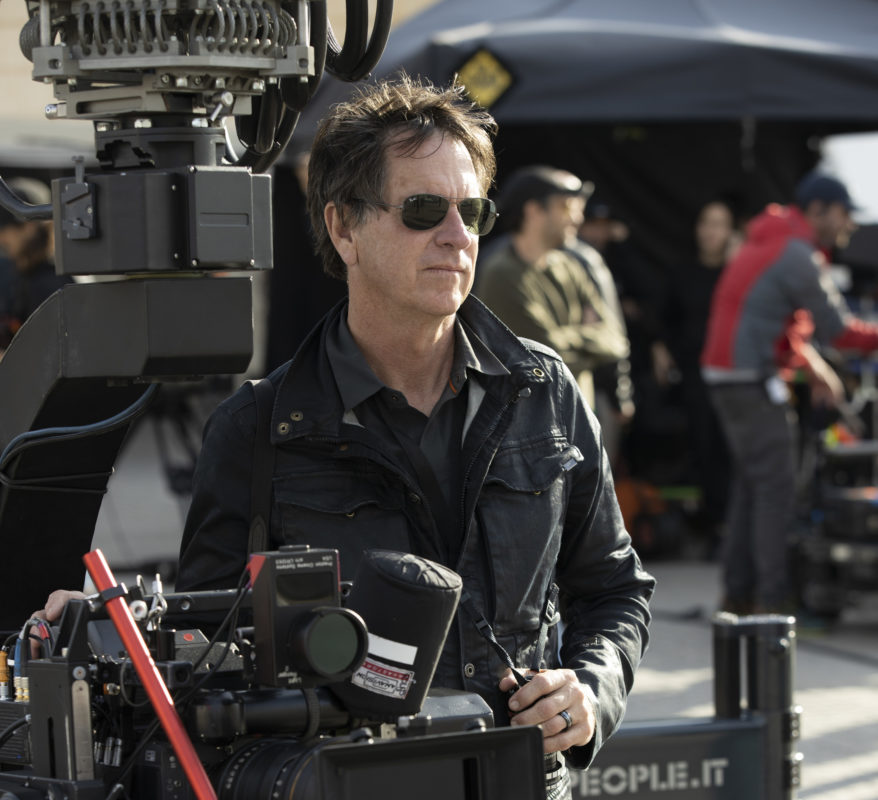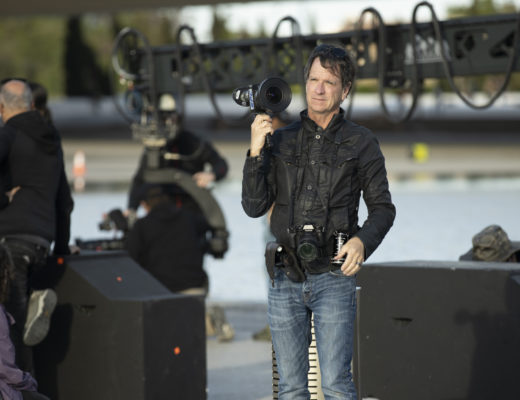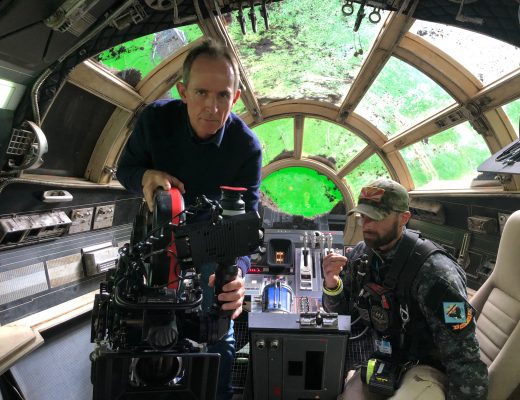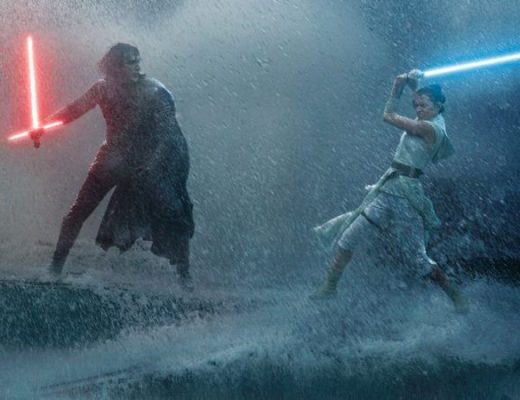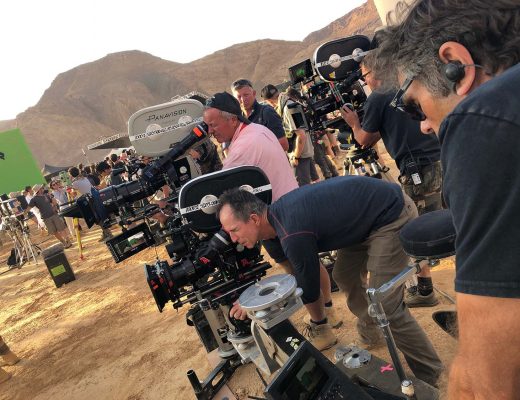
Acclaimed cinematographer Paul Cameron, ASC has worked on quite a few visually groundbreaking films, including his first big feature, Gone In 60 Seconds, then Man on Fire, Collateral, Deva Vu, the 2012 remake of Total Recall, the latest Pirates of the Caribbean movie, The Commuter and the last film of his to come out, 21 Bridges. He’s also shot a few Super Bowl commercials!
His cinematography for director Michael Mann’s 2004 film, Collateral, was one of the first Hollywood studio films to embrace and reveal the potential of shooting with digital cameras. But Paul still adores the medium of film, and shot the pilot for HBO’s Westworld on 35mm film, earning an Emmy Award nomination and an ASC Award nomination in 2017. In a wide-ranging conversation, we talk about his work with Tony Scott, how he translates a script into imagery, and of course his work as both a cinematographer and director on Season 3 of Westworld.
Part 2 coming next week. And look for episode 2 of the Art of the Shot podcast to hear the full conversation now. Available on your favorite podcast platform.
Derek Stettler: So how did you come to be a filmmaker? And are there any experiences during your childhood that have particularly shaped your aesthetic and what you bring to the craft of cinematography?
Paul Cameron: That’s a good one. I was still in university in 1976 and I started shooting rock & roll, I think my first music video was for the B52’s and Rock Lobster. To keep a very long story short, I came up through New York and early rock & roll and started doing some commercials and independent films there. But I started absolutely on my own, didn’t know a soul, went to university and went to New York City as much as possible, and New York Film Festival as much as possible. I kept very active and saw a lot of people filming around the city and realized I had to get into the union. And in order to become a cinematographer, I had to shoot anything I could. So I started shooting as much as I could and that included a lot of early pre-MTV rock & roll and then obviously MTV and then into commercials and films.
Stettler: And so what really initiated your passion for cinema and actually being involved in the craft of creating it?
Cameron: I lived in New York City for most of the time in junior high school and high school, and lived with my older brother, Peter Cameron. At the time, he was a regular working actor off Broadway, for the most part, and did a lot with the Public Theater downtown in Manhattan. So I was around theater a lot while I was living with him. And of course, he took me to countless movies, including 2001: A Space Odyssey and Clockwork Orange, and obviously all the Woody Allen films, the classic cinema films, including 70s films like Serpico, and a lot of great films like that. So, I was around that world, just mentally. And when I had the opportunity to go to university, I just felt like I had to go toward that direction. I didn’t know a soul in the business or anything and just went for it.
Stettler: So, did you have a big break that you particularly attribute to where you are right now in your career?
Cameron: I did a lot of commercials, and a few independent films for probably the first ten years of my career and then made the move out to California from New York to shoot out there a bit. I was trying to do bigger movies and I was just at a point where I felt like I was having a good career, if I wasn’t able to shoot big movies I’d be happy with what I was doing, which I was. And literally a week later, I got a call from Dominic Cena and Jerry Bruckheimer to shoot Gone in 60 Seconds. So that launched the big movie path.
Stettler: Did you feel prepared for that? Or were you sweating bullets, so to speak, and super nervous?
Cameron: I think super nervous is a good way to put it. But I was ready. I was at a time in my career where I think I was putting tens of thousands of feet of film regularly through the gate and was ready to go. A quick anecdote is that on the first couple days of Gone in 60 Seconds, there were actually night shoots and I had planned with the AD and director all these massive sequences with chases, and helicopters, and car-to-car, and rigs, and dramatic scenes, and everybody was looking at me like, “Are you sure you want to do all this?” The producer came up to me at the end of the first couple nights and he says, “Are you going to keep this pace up the whole time?” And I’m like, “I don’t know.” And he’s like, “No, you’re not. We just wanted to see if you could do it and you did a great job the last two days but we gotta take things down.” We did so much work in the first couple days, but it felt right. You get the break, and then, when it feels right, it feels right. And it was just great timing for me.
Stettler: Yeah. Well, you’ve certainly had a pretty outstanding career since then. And I know you’ve worked a lot with Tony Scott. Right?
Cameron: I did two films with Tony and a short called Beat the Devil, one of those BMW films.
Stettler: Oh yes, I’ve seen that. That was amazing.
Cameron: Yeah, it’s got James Brown and Gary Oldman, Clive Owen and even Marilyn Manson. So that was a fun one, actually a test. It was the typical Tony Scott thing where he said, “Hey, we’re going to do this little film for BMW and I want you to think about this movie I’d love for you to do down in Mexico City.” And I’m like, “What movie?” And he said it was called Man on Fire. And so Beat the Devil was kind of a photographic test, which turned out to be be something I was very proud to be on. Even still. It was a great film to shoot for Tony, that little short at the time was fantastic.
Stettler: Yeah, that was a very cool series BMW did and you guys used some very interesting photographic techniques, obviously on Man on Fire, but on that short as well.
Cameron: Oh yeah, it was great. We started adapting more modern cameras to hand crank and we were taking reversal film stock and hand cranking and developing it cross process, like a negative stock, and getting insane dailies back. It was exciting and a good collision at the time working with Tony for me creatively.
Stettler: Oh, I can imagine.
Cameron: He was a great guy, and a great friend. I miss him dearly. He really supported every cinematographer, every single day. He just loved painting a good scene, and cinematography had a lot to do with it. So he was very, very involved.
Stettler: Yeah, he’s really one of the great stylists in his generation, if not the history of cinema so far. There’s a lot that I imagine you experienced working with him that he imprinted on your work. Is there anything that you bring to your work today that you really attribute to him that maybe you’ve done on Westworld, for example?
Cameron: Yeah, I mean, for me, Tony was very influential in a lot of ways. He encouraged the use of multiple cameras when possible. Certainly shooting with two or three cameras at one time, even in a small room, that was kind of a prerequisite [laughs]. And so I think showing me a kind of fearlessness with being able to shoot close-ups slightly off angle, or maybe we weren’t matching lens sizes, we might be going for a more raking shot that had more emotional value, so there was a different approach to the coverage oftentimes. And he loved natural light and we constantly tried to push things toward as much natural light and I tried to light things where he thought it was natural light. It was a great challenge working with him, because he was very appreciative of the results we were getting and he could see the passion for shooting reversal film and cross-processing it, hand cranking and shooting shots on 16 millimeter and cross-processing that. Or skip bleaching 100% on the negative. Anything that was an idea that I supported with a test, he was just constantly letting the line out to go further. So it was great.
Stettler: I can imagine. On Westworld, it seems like you’ve absolutely carried over the multiple camera aspect of that, in terms of getting a lot of coverage at once. But the show has such a very intentional feel to it. It’s very cinematic, and it was from the very beginning. So how do you balance the needs of cinematic lighting and that very focused, singular perspective of a single camera show, but doing so with multiple cameras? How do you plan that out? And how do you balance the needs of the that?
Cameron: Well, I think the balance really comes from the prep, and in this case Jonathan [Nolan] loves to shoot great scenes, but he also has ideas for many additional shots, and of course I have ideas and we storyboard some stuff and then we just run and gun and hit it the way we want to do it to get the shots we want to get. But it’s seeing the rehearsal and then zoning in and throwing in an extra camera there to get one small gesture or look that says a million things that another camera with more conventional coverage might not get. And I think that’s the primary use of it, and we would rather try and realize that it doesn’t work later than not try it at all.
Stettler: So, as far as I am aware, you were involved with the show from the very first episode of Season One, and then you haven’t been involved since then. But you came back for episode one of Season Three, in addition to directing episode four. Is that correct?
Cameron: Sounds pretty good. Yeah.
Stettler: Okay. So what has it been like, coming back after all this time and as the story has shifted so much and now we’re in a totally different part of the world that we’re seeing. How has the process of crafting the show changed between then and now?
Cameron: One of the best experiences was getting the call from Jonathan Nolan to meet and talk about doing Westworld, and being involved in the initial scouting, and the conceptualization of what the world was going to look like with the Western town and how to situate the park in Utah. And that actually carried over and I shot a shot a bunch of scenes for various directors in Utah for Season One, over a couple weeks. And then I actually did the same thing again on Season Two and I shot in Utah for a number of directors for a couple of weeks. And so I carried through that second season a little bit but when Jonathan and his wife/co-creator Lisa Joy contacted me about this season, they wanted to re-establish the look. They offered for me to shoot the series, at least the pilot, which I did, and offered for me to direct the fourth episode. We started the year traveling around Asia and Europe looking for locations and to be part of Season Three. I was watching him begin to write the ideas and ask what is L.A. in 2058 and we decided to shoot in Singapore and make this hybrid world. These levels of involvement to me are much more interesting in a lot of ways. It’s not just show up and scout and shoot. It’s let’s form the ideas, go to the cities, scout it out. On this season, I shot Jonathan’s episode, but I also went to Singapore and shot many scenes for various directors and episodes, as well as directing two days in Singapore, myself. And then went to Spain and shot for additional directors. So it’s been quite an experience all around, to be part of all the episodes on some level and great to be able to see the whole picture of a series like this.
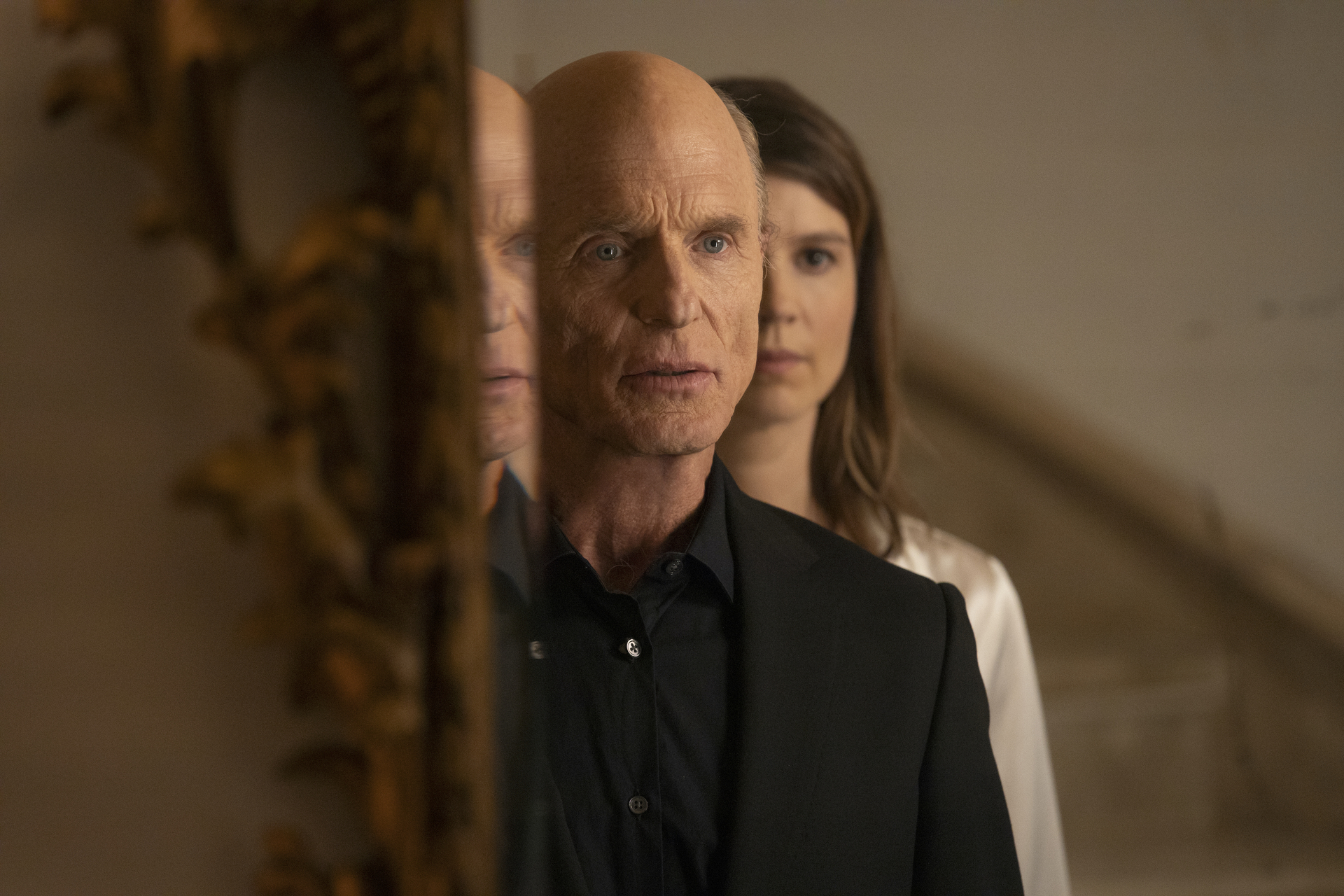
Stettler: That’s an interesting point which people would never otherwise be aware of, because your credit is only on one episode, even though you’re involved in the season as a whole. One of the questions I want to address is about the philosophy behind a lot of the choices that are made. Because the show has this feeling of a singular vision to it, so the fact that there are so many cinematographers that have been brought on and numerous directors over the seasons, and yet it still maintains that cohesive feeling is, I think, a testament to Jonathan Nolan and Lisa joy and their work as showrunners. But also your involvement from the beginning and setting that tone, visually.
Cameron: Yeah, and I think it’s been great to watch the arc of a show like this. I haven’t done television series all the way through, I’ve just done features and commercials for many years now and a couple of pilots. So to be involved on this level has been exciting, more creatively challenging, and there’s more responsibility. We’re getting directors of photography to come shoot with us around the world and some of them have less experience shooting 35mm film, so it’s about how to give everybody the confidence and support they need with the right camera gear and crews and lighting/grip and put them in the right position to do some good cinematography for these episodes. Even shooting in Singapore, we shot multiple units, we probably shot three units simultaneously every day and sometimes a night unit, and we’re overlapping, and some days I was directing and shooting the same day, and again there were multiple directors. So that was interesting for me because that was very difficult. It’s not only the responsibility of directing a couple major scenes in Singapore, but then to shoot for Jonathan on episode one, in many, many locations and coordinate all the drone work and all the other units… it’s a little time consuming. It’s a long day, let’s put it that way.
Stettler: Yeah, well I imagine more than that. It must be incredibly mentally demanding to be able to switch gears and actually be effective in both roles like that. How did you actually manage it and pull it off? Was there anything you discovered that was key to helping you be successful in doing that?
Cameron: No, luckily I directed episode four and I had 12 days of shooting in Los Angeles, and then I had two days of shooting in Singapore. So I had already done the 12 days in Los Angeles, and it was a fantastic opportunity and challenge that Jonathan and Lisa gave me, and I assumed they were going to give me this action-filled, hallucinatory episode, and of course when I got the script, I realized I got a very dramatic episode that had big character reveals in it and some big stories and a lot of exposition. You get 10 days to prep an episode and I think I got the script after five days, so I think I had two locations and a couple actors, so it was great. They’re so supportive and Jordan Goldberg, the writer, is great, a great teammate to run with on the show. Jonathan and Lisa are so supportive, but they barely showed up when I was directing, which drove me crazy because I was hoping they would be around more. And they were like, “No, no, no, you got it together, you do it!” And they also let me have some input with Jordan in the script on episode four in the opening sequence with Ed Harris, where he was pretty unhinged in the beginning and the confrontation with his daughter up in the bathroom. That sequence I basically designed and pitched and they loved the idea and adjusted the opening of the script for it so I could do it. It was a great collaboration, and I’d love to do it again with them. So I hope I have the opportunity.
Stettler: And had you asked them to direct an episode or was it just offered to you? Did you have to prove yourself somehow?
Cameron: No, I guess it was time. They had spoken to me about directing in the past, I think maybe they wanted to give me the opportunity in Season Two, but I don’t know if HBO was ready to do that. And then, when I had the relationship with HBO and JJ Abrams, and everybody at Kilter Films, and they could see the level of films I work on and the level of work on the show, I think they wanted to put me in the driver’s seat and see how I do. They just pushed me into it. In a good way! [Laughs] You get your script and you make it happen, and we did it. I had all the top actors in the episode, which is fantastic. So I had the chance to work with everybody. It was shocking to me. When I read it, I’m like, “Why didn’t I get the episode with two characters or a simple relationship that moves forward or something.” But no, I didn’t get that episode. So it was good.
Stettler: An amazing challenge. Well, speaking of the actors and the challenges on the show, I know Evan Rachel Wood has called Westworld the Acting Olympics recently. So what was the process like for you suddenly relating to the actors as a director? And what did you learn about how to get a great performance from an actor?
Cameron: Westworld for a director is like being a coach of the Acting Olympics for sure. Very few shows have that many top actors, so it really is to watch them work together and how they elevate their own work. The gift is really when they elevate each other’s work. And when you see it, you watch them feed off of each other and then they take it to a new place and you can tell these people are jiving, they’re firing on all cylinders, and they’re getting something from each other. So, it’s a bit daunting, as a new director, you call cut. You can’t just say, “Oh, that’s great.” You have to get in there and talk about that take. “You did this.” “I love that!” “Let’s talk about this.” “I love this moment when this happened and I want to know why you guys took it to here.” “I want to know why you did this, etc.” You’ve got to come up with a conversation and deal with not only the material that you’re trying to bring onto screen, but how they’re relating to it and their fusion with the whole thing. So, I guess it’s the equivalent of having an Olympic team where you’re the coach and they’re all on the bus and they open the door and they’re like, “Okay, get in!” And you look in the bus as you walk on, and you’re like, “Wow, these are some of the best athletes in the world here!” But the bar is set so high on this show, you’ve got to have your game on and you’ve got to really understand the writing, you’ve really got to understand the show, you really have to understand a plotline that the actors aren’t familiar with yet but that you have the knowledge of and how to put them in the position of being somewhere dramatically when they don’t even know yet exactly why or the exact position they’re in until the next episode. So it’s a balancing act, and for me I felt very comfortable doing it and talking with the actors, and it was great to work with the DP John Grillo, a show regular now, along with Howard Cummings, the production designer. So I have familiarity with wardrobe and makeup and visual effects and special effects. I like to work fast as a director of photography, certainly as a director there’s even more pressure, balancing a lot more acts there. So it’s great to have a little support.
Stettler: You mentioned moving quickly and when you were telling me about the amount of days, is that for the entire episode? It was only 12 shoot days?
Cameron: Yeah, it’s 12 plus two. So we did 12 days in LA and two days in Singapore, so 14 days.
Stettler: Wow, so 14 days to shoot an hour of extraordinarily high-quality, cinematic content. How do you make sense of then going on to a movie and doing that same caliber of work with twice the runtime but in four to five times–or more–of the shooting time?
Cameron: Yeah, that’s the challenge. The amazing thing with the level of Westworld and these types of shows that are functioning at this level is that we’re constantly striving to make this great product, and then there’s the real reality of the amount of days you have to shoot it. And that’s the complex thing. And that was daunting for me in the beginning, going through that first script with the AD, Carrie Bruno. I sat with her and I’m like, “Geez, what do you think?” We battle back and forth. It’s too much for the number of days we have and they make some adjustments and in this case, once we had it locked in, I knew we could do it. There was a big auction sequence in my episode where John Gallagher is brought to a party and taken away by Jeffrey Wright and people are being auctioned off and it’s a lot. You read that on paper and then you realize you’ve got a little over a night to shoot that sequence and half a night for the fight upstairs and you’re like, “Okay that’s crazy!” On a movie, we’d have four days for the downstairs and we’d probably have two days upstairs for the fight, or maybe do the fight in one day, but I did the scene downstairs which has double beats, it’s got six or eight characters and four different blocks of action and a lot of exits and entrances to make sense of the geography, and 200 extras, and naked people. And of course, we went behind on the second day, and I had like three hours to shoot the fight sequence with Evan and Luke. It was great because having shot a lot of fight sequences as a director of photography, you have an idea how to get through it and make it dynamic and give up all your specialty ideas or little nuances and just drive for the great shots and setups to make the fight work. And then if you have a little bit of time, you clean it up. So, I liked the challenge. You get it done.
Stettler: Those are the moments that don’t just stretch you but really test everything that you have gathered over your experience, everything you’ve picked up, and everything you’ve internalized about how to make a scene actually work and what really is necessary. But the fact that you have such a short amount of time compared to what occurs on a film, to achieve essentially the exact same outcome, actually. It doesn’t feel like it’s compromised, or like it’s a watered down version of what you’d see in a feature film…
Cameron: Honestly, I think on the bigger films that we do, like the last bigger one I did like that was Pirates of the Caribbean, where you have insane resources and a 95-day shoot scheduled with an additional 20 days of photography after that. I just did a film with Lisa Joy and the film I did before with Brian Kirk where you start out and get the 55 days and by the time you’ve scouted and you’re about to do your tech scout you’re down to 42 days. And suddenly the money is less and the time is less, and due to actor availability, your schedule gets flipped around, and you can’t do certain things the way you want to do them. And I’m finding more, with my limited experience shooting streaming and movies, that it’s also on the producing end and on the studio end, they’re seeing it similarly. Remember that movie of the week phase? Where they shoot 10 pages, 15 pages a day? Well, we’re doing that. Maybe we’re doing six or eight on a big show or two to four on a big movie…
Stettler: Yeah, the numbers are the same, but it doesn’t feel compromised like I feel you’re saying it used to be. So what have you learned by actually being on both sides of it? On the huge films that have the amazing schedules and on Westworld, where you’re achieving still very high quality, feature-film-caliber content, and dynamics between actors are all there. It doesn’t feel compromised in any way. And yet you’re doing it on a very short timetable. So what do you account for that? And what lessons would you say you’ve gotten from that, that you could share with people who want to achieve that kind of quality but don’t have the time on their projects to do it?
Cameron: Well, I think there’s a magic to every shoot day. As well as you schedule it, on many days, it’s a miracle you make the day. I think here, what I took away from directing is being humbled by the experience, because now, after working as a director of photography for so many years, I’ve relied on many department heads, and I’m used to that communication. But suddenly directing, it’s all the department heads. And it’s every detail. And it’s every detail of every word. It’s every detail of every costume. It’s every detail of every makeup, of every prop, of every edit, of every sound effect… of everything. So it certainly made me appreciate directors, specifically the ones I know and love even more, and what I took away as a DP is a reminder to really help directors take care of every possible thing they can, every detail with every department and be on top of it; to be a great collaborator in every way. The more you empower people, and that’s the thing, and I learned this as a DP, as soon as you empower a good crew and give them good leadership and give them clear information and help them execute things and celebrate their work on it, the better results you’re going to get. And I was fortunate because I had a great group of people. From Jonathan, Lisa, and the people at Kilter Films, to the support of HBO and JJ Abrams, and these people just said go ahead and do it. Don’t be afraid. So it’s nice. It’s nice to have that vote of confidence.
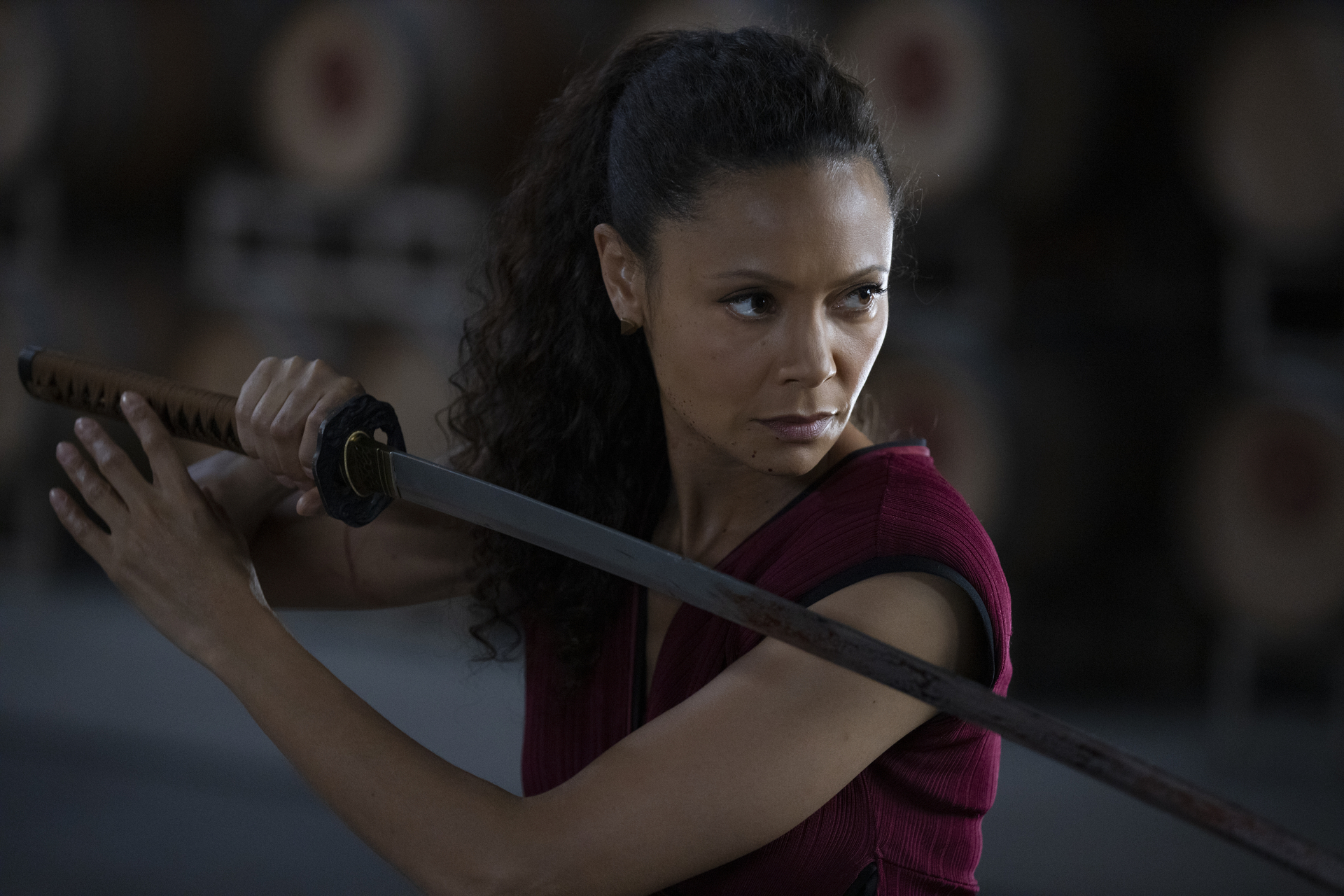
Stettler: Well, when they empower you like that, you’re given the resources to be empowered, but then they also entrust the confidence in you to be able to use them. I was reading recently about the virtual set technology that was pioneered for The Mandalorian. And then I heard that was shared with you guys and it was utilized this season. And then I also know that in Season One, you guys did something that seems a bit out of the ordinary, especially these days, where you built sets in Utah specifically to capture the background landscapes for very real, in-camera effects, rather than using green screen to achieve that effect. And then in this season, you used an intermediary solution that had the benefits of both green screen and real locations. So were you involved much in the episodes that used that technology, and if so, can you talk about the process?
Cameron: Of course. The great thing collaborating with Jonathan is that his first feeling is: “How do we accomplish this in camera as much as possible and how can we make the illusion as authentic as possible with the least amount of visual effects?” And that goes from the pilot in Season One and the work that we did in Utah where we’d bring set walls and shoot the reverse angles where the actors look out toward the windows and then they walk out onto the porch and have a couple lines of dialogue in Utah and then shoot the reverses back in L.A. inside the set. Or whether it’s the balcony at Deadhorse Point for the Delos Corporation, shooting on a piece of steel deck with a railing and then comping in the walls behind on the edges of the park. So this has been a great collaboration and being able to conceptualize how to do it. But this year, during pre-production we went and looked at The Mandalorian set with John Favreau and Greig Fraser and Barry Idoine shooting it, and we absolutely fell in love with this idea of a virtual set and a 3D LED environment. Where all reflections and light were natural for the most part. Obviously, the needs for Westworld didn’t mean getting a massive stage with LED walls. We’d never had the opportunity really to do the LED wall because there were no people driving or anything that we traditionally use LED walls for. So on this season there’s a couple big sets, like the board room and an office for Tessa Thompson, and we built it with the idea of shooting it, designing it with super reflective floors and shooting it with practical LED walls. We also did it with all the futuristic drones in the show, all the drone work was done against the LED walls and much of the the jet interior that you see, which functions on a few different sets, that was predominantly done as an LED wall as much as possible. So, again, part of putting the show together with Jonathan and Howard Cummings is really the time where we research the technology, we go out and we look at it, we see the application, ask what’s the advantage of going 100% analog and what’s the newest technology and what’s the best creative choice for executing something. That’s the drive.
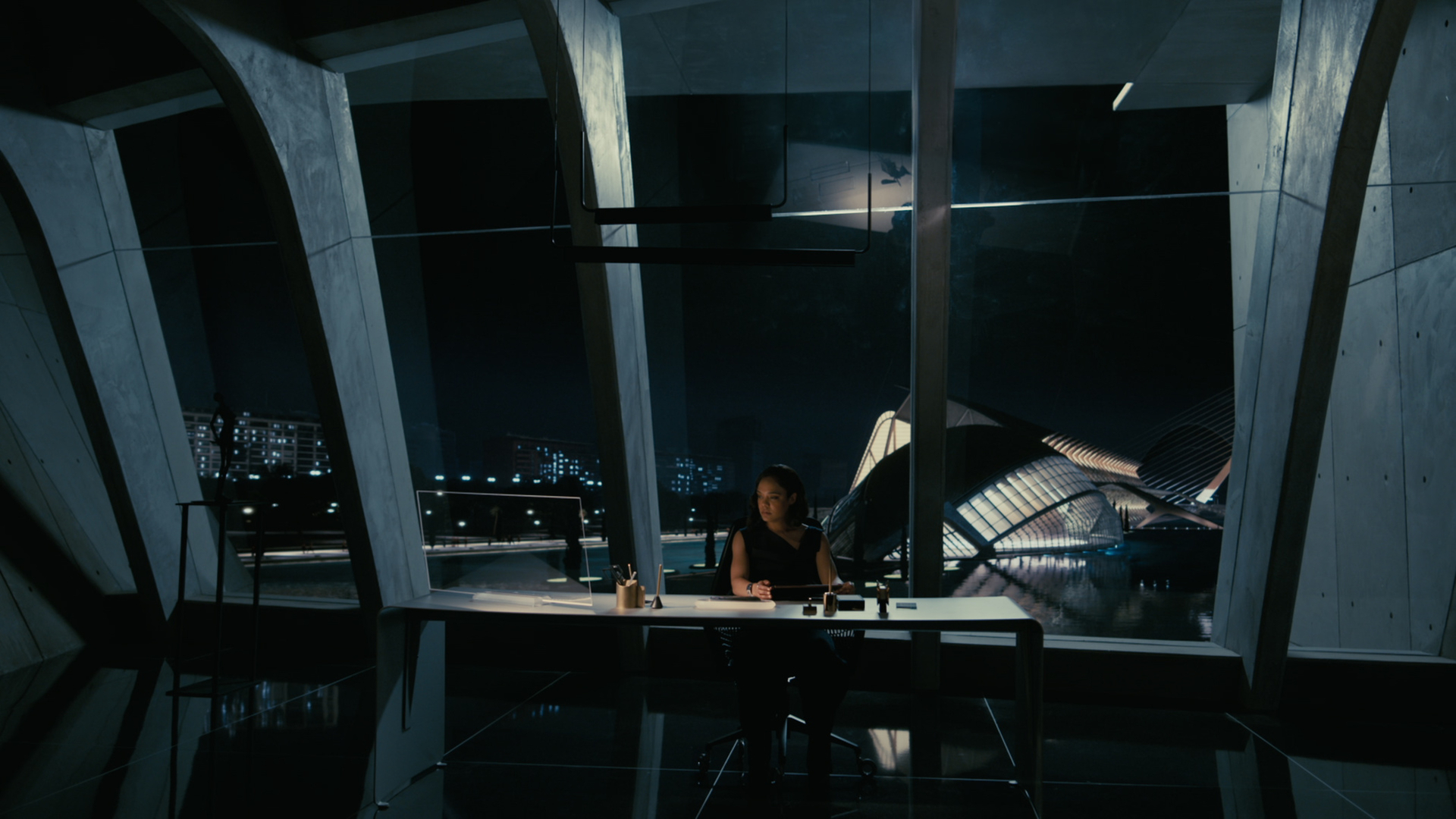
Stettler: Some of those sets on this season really stood out to me. I was thinking, “Where were they? Where did you find that kind of a location?” And now I’m starting to understand that it was a mix of real locations and the virtual sets, which made them feel like they were real, but actually, they were recreations of things.
Cameron: Actually, not so much. You’d be surprised. The jet is a massive set that they built, the boardroom was a massive set…
Stettler: Yeah, it didn’t exist. So you didn’t go somewhere where that is a corporate office somewhere?
Cameron: Yeah, but the Delos corporation basically exists. It’s a building in Singapore that’s been placed in this hybrid city, Los Angeles 2058, which is a combination of Singapore and Los Angeles and based on a vertical architecture with overflowing rooftop gardens. So it was really insane how much we shot interiors in Singapore, even on my episode. I had two of the most gorgeous locations that we saw in Singapore. One was the Atlas Bar, which was a big scene with Vincent Cassel and Thandie Newton. And the Atlas Bar is a brand new bar, one of the most expensive bars in the world. It’s three stories high, art deco interior, floor to ceiling just packed with priceless bottles of booze that have to be fetched on ladders, like old libraries. And then the National Gallery, which used to be the Singaporean Supreme Court, which they turned into a National Gallery museum, is basically a melding of the old Supreme Court with this glass structure engulfing it. So I lucked out with two fantastic locations and then we shot so many beautiful big locations there with various directors that are actually interspersed throughout the season. So it’s that and a lot of exterior drone work that we tied in with some some big exteriors.
Stettler: Yeah, the creation of that future Los Angeles in 2058 is such a compelling vision. And it feels so realistic, so grounded in something that we would recognize as the future and yet, a real world now, but just not Los Angeles in the way that it currently exists. So I really love what you guys did with that. And you mentioned the drone work, which makes me wonder, are you shooting with film cameras on drones? Or is the drone work digital capture integrated with film?
Cameron: Well, we actually do prominently film drone work, still. 35mm cameras on drones, believing it or not, as much as we can. There’s some significant aerials in Los Angeles we did with a system I built with an aerial company called Pursuit Aviation, along with the drone company we use a lot–XM2–where we rebuilt an entire old Shotover gyro stabilization rig for the helicopter to hold an Arri 535 film camera and fit the film magazine. So we were able to shoot film for the helicopter work, and we did use a slight amount of digital on the show, very, very sparingly. I did all of the night aerials with the Sony Venice at the 2500 base ISO. So I could use a zoom lens at f/2.8 and get all the detail and that was amazing. So we do bounce around a little. In Singapore, we ended up doing a lot of the drone work on an Alexa Mini off an octocopter ship, only because there were certain tether requirements that we were set up to do with those rigs and not on the film drones.
Stettler: Okay, that makes a lot of sense because the night shots on this season are absolutely pristine, and they are highly detailed and very rich.
Cameron: Yeah. And the funny thing is there’s only a few drone shots, along with the night aerials, and occasionally a wide shot for a scene here and there [that we shot digitally]. But we did some massive testing at the beginning of the season, and Jonathan, Lisa, and myself feel very strongly that it was okay to have some wide shots off of the Sony Venice to get that detail in the night in the 2500 mode, but as soon as we went for medium or close up, we went back to film. It’s just our MO.
Sign up for our newsletter to hear when part 2 and 3 go live!

Filmtools
Filmmakers go-to destination for pre-production, production & post production equipment!
Shop Now